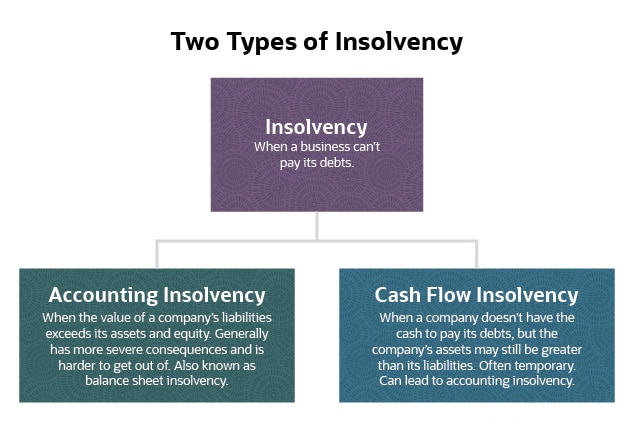Insolvency Practitioner for Dummies
Insolvency Practitioner for Dummies
Blog Article
Insolvency Practitioner for Dummies
Table of ContentsHow Insolvency Practitioner can Save You Time, Stress, and Money.Some Known Facts About Insolvency Practitioner.Get This Report on Insolvency PractitionerWhat Does Insolvency Practitioner Mean?4 Easy Facts About Insolvency Practitioner ShownInsolvency Practitioner Can Be Fun For EveryoneOur Insolvency Practitioner Statements
Insolvency is when responsibilities are more than the worth of the company, or when a debtor can not pay the debts they owe. A company can come to be insolvent because of a variety of scenarios that cause inadequate money circulation. When confronted with insolvency, a business or individual can call creditors directly and restructure financial debts to pay them off.Bankruptcy can lead to insolvency proceedings, in which lawsuit will be taken against the insolvent person or entity, and assets may be sold off to settle superior debts. Company owner might contact financial institutions straight and restructure financial debts into more workable installations. Lenders are typically amenable to this approach because they intend to be paid off and prevent losses, even if the settlement gets on a postponed routine.
A Biased View of Insolvency Practitioner
The proprietor produces a proposition describing exactly how the debt might be reorganized utilizing cost decreases or other prepare for assistance. The proposal reveals financial institutions exactly how business might generate enough capital for successful procedures while paying its financial debts. Commonly, a forgiven financial obligation may be taken into consideration income by the Internal Earnings Service (INTERNAL REVENUE SERVICE).

The 30-Second Trick For Insolvency Practitioner
Business may finish up paying large amounts of cash in damages and be overcome operations. When operations discontinue, so does the business's revenue. Lack of revenue leads to accounts payable and creditors asking for money owed to them. Some business end up being bankrupt since their goods or solutions don't evolve to fit customers' changing needs.
Costs surpass incomes and bills remain overdue. Sorts of bankruptcy include cash-flow insolvency and balance-sheet insolvency. Cash-flow bankruptcy happens when a firm has the assets to cover their financial debts however they remain in the wrong form, such as realty rather of fluid funds. Balance-sheet insolvency, on the other hand, shows an absence of assets in any type to cover financial obligations.
The internal revenue service states that an individual is financially troubled when the overall liabilities exceed total properties. A personal bankruptcy, on the various other hand, is an actual court order that shows how a financially troubled person or company will certainly pay off their lenders, or just how they will market their possessions in order to make the settlements.
Getting My Insolvency Practitioner To Work

Understanding the variables that can lead to insolvency, such as overspending, can help you protect against insolvency and its consequences.
The 10-Minute Rule for Insolvency Practitioner
It is popular that directors and police officers of firms (and supervisors of restricted liability companies) owe fiduciary read this obligations to their organizations and their shareholders (or participants). These fiduciary responsibilities are specified by state statutes and, though there are variations from one state to another, they typically consist of a duty of commitment and an obligation of care.
The task of treatment calls for directors and policemans to work out persistance, to make informed choices, and to act in good belief to make sure that their actions remain in the very best rate of interest of the company. Though past the range of this conversation, some states enable these duties to be restricted either by so noting in the business papers or abiding by various other needs.
Insolvency Practitioner Fundamentals Explained
Many states define insolvency in 2 ways( 1) when a business's liabilities come to be more than the amount of its assets or (2) when the business ends up being unable to pay its financial obligations as they end up being dueand welcome both definitions (Insolvency Practitioner). The change in duties takes place because when a firm is financially troubled, there is no value in the firm past that owed to the business's creditors to make sure that the equity holders no longer have a financial stake in the firm
Take care about giving investors favoritism at the expenditure of financial institutions (e.g., authorizing and funding a dividend or a supply redemption). Be cautious regarding favoritism in between courses of investors. Clear up initiatives to find out all the realities prior to taking a certain course of action; supervisors should genuinely think that any type of decisions made remain in the best interests of the company in its entirety (i.e., decisions will be evaluated in hindsight due to the result of such activities on you can try this out the company).
In any type of continue reading this personal bankruptcy or bankruptcy proceeding, repayments made to particular financial institutions at the cost of other lenders can be clawed back, specifically if there is some connection in between the company and the creditor. Take into consideration recommending at an annual shareholder meeting (or any various other conference of investors) a resolution verifying that all prior business decisions and actions taken by the supervisors and policemans of the firm were taken in excellent belief after an exercise of sensible treatment.
6 Simple Techniques For Insolvency Practitioner
Completely divulge any personal or company partnerships with parties on the various other side of purchases entailing the firm to avoid the appearance of a conflict of interest. In reviewing potential fund raising purchases or a sale of properties of the troubled company, know that these transactions may be inspected later on due to any kind of succeeding expansion of supervisors' fiduciary duties to consist of lenders.
Report this page